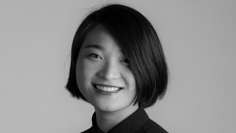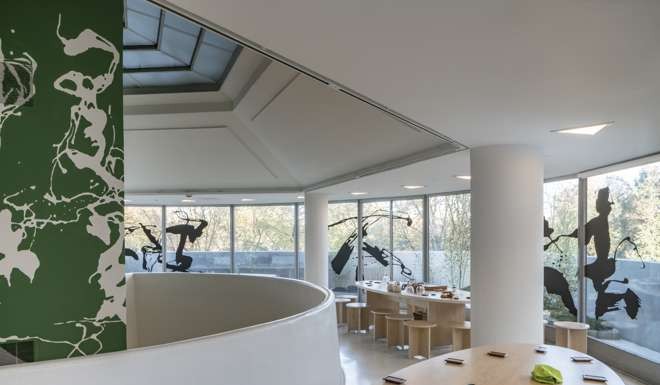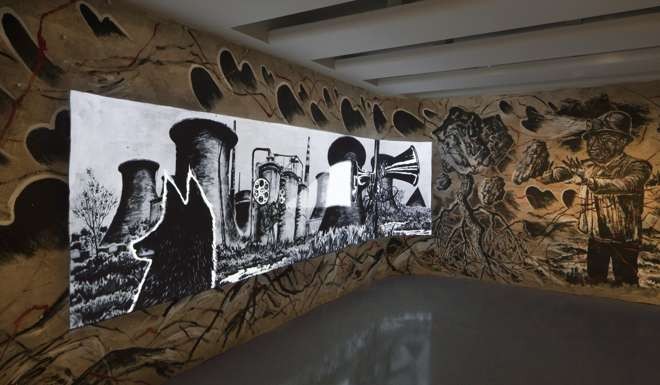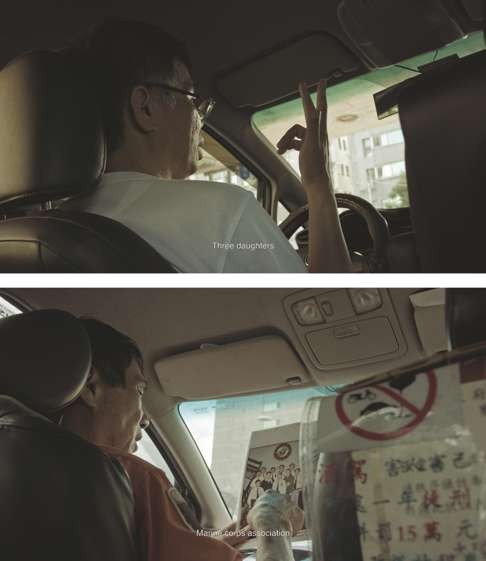
Guggenheim’s pick-and-mix Chinese contemporary art show, from a spewing industrial robot to calligraphy with tea
Hong Kong-backed exhibition intended to pique the curiosity of museum-goers, not give them a full picture of art scene in China, curator Xiaoyu Weng says

Visitors to “Tales of Our Time” at the Guggenheim in New York won’t be getting the full picture of Chinese contemporary art. That’s because they’re not supposed to, says Xiaoyu Weng, the museum’s associate curator of Chinese art.
Those who try to place the new works from China on show within the wider context of artistic movements and styles may struggle, she says, as the artists were picked for their individual approaches to art.
“People won’t be able to acquire a total knowledge from these artworks – they won’t be able to work out what’s going in the wider sphere of Chinese art from them,” Weng says. “This show focuses on individuals. It’s a piece of something much bigger which is meant to open people up to ideas. If the exhibition creates a memorable experience and triggers a further inquiry to gain knowledge, then its aim has been fulfilled.”
“Tales of Our Time”, the second show at the Solomon R. Guggenheim Museum to be supported by the Hong Kong-based Robert H.N. Ho Family Foundation Chinese Art Initiative, uses a suitably wide and diverse range of artworks to make its point.

The most salient work on show is a giant industrial robot, Can’t Help Myself, by artists Sun Yuan and Peng Yu. Encased behind glass for safety reasons, the neck-like machine whips around viciously and spews a reddish-brown liquid towards viewers.
Equally beguiling, Sun Xun’s multimedia installation Mythological Time consists of paintings and animated video, and draws parallels between the past and the present, mythology and politics.
The Yangjiang Group’s calligraphic work Unwritten Rules Cannot Be Broken is augmented by a tea house, where visitors can sip tea, talk, and look at the art.
The group show features eight artists and groups, and runs at the Guggenheim until March 4.
Can’t Help Myself has been getting a lot of attention in the gallery, with some viewers seemingly mesmerised by the mechanical beast. It’s a very forceful piece of art.
“You get what it’s trying to say immediately,” says Weng, who worked with consulting curator Hou Hanru on the show. “But this immediacy actually has many layers. People think of violence and blood when they are watching it, and also of an authoritarian control system. But the repetitive actions of the machine also have an absurdity to them.”
The machine is made by a commercial company, and has been used for applications in the car industry, among others. Peng and Sun Yuan programmed its movements for the exhibition.
“If you watch for long enough, you establish a weird relationship with the machine” says Weng. “You feel that it has some kind of life of its own, or that it could even be a pet of some sort.”
The Yangjiang Group’s Chinese tea house has been popular with visitors, too, although “a lot of people have thought it was Japanese”, Weng says.

The group was formed in 2002 in the small coastal city of Yangjiang, in Guangdong province, where the members would watch soccer, play chess, and go to shopping malls together, as well as create calligraphy. Although they have exhibited internationally, they have remained outside of the mainstream Chinese art world, says Weng.
The idea of the tea house was to engage people with calligraphy in a popular way. Calligraphy is now usually an elite pursuit, but a few hundred years ago it was an everyday skill. The Yangjiang Group are trying to take calligraphy out of academia and bring it back to the people.
“The art they practise is very much part of their everyday life. For them, this it’s just a normal day – they practise calligraphy, they drink tea, and they have conversations. We were drawn to their idea of making a little utopia of their own, in their own place,” Weng says.

The collective is not consciously working outside the system, she says: “It just comes naturally to them, in part due to where they live. That kind independence and autonomy gives them a unique perspective which is not tainted by the art world dramas of Beijing. They are not trying to find a path or a formula to a career.”
Although Weng stresses the individuality of the artists, she says there are some underlying themes to the show, including how history is perceived.
“There are two clear paths to enter this exhibition – history as a construct, and the history of specific locations,” the curator explains. “The exhibition challenges the belief that history is one single layer, or one single truth. The artists are giving different possibilities, and are not trying to claim that their version of history is the true version.”
This idea is made explicit in the in the video Taxi, by Taiwanese artist Jao Chia-en. Chia filmed conversations with cab drivers in Taipei while they drove him to places of cultural significance, such as the Grand Hotel. The location was notable before the hotel was built – it was the site of the Taiwan Grand Shrine, the island’s most important Shinto shrine during the Japanese occupation. The Kuomintang government often obscured the true histories of locations and structures, and written records are difficult to find. But such histories often remain in the personal memory of the population.

“The drivers often know what the sites used to be. Many people find these stories very interesting,” says Weng.
“History is written by those in power, so what we hear every day is just a mainstream version of what happened. Jao wanted to work with the taxi drivers to tell a different history based on personal memories. These histories can be can be flawed, too, but they can also be true.”
Weng believes that, unlike the previous generation of contemporary Chinese artists who had a collective approach, the current crop is more individualistic.
“The idea of the individual does not only relate to the way these artists express themselves – it also relates to their subject matter. The taxi drivers Jao talks to are individuals. They each have a very individual story about history, and how their own personal histories relate to the city’s history,” she says.
The concerns of the artists in “Tales of Our Time”, says Weng, are international, even if they are specifically located within greater China, Chinese history, and Chinese mythology.
The idea of ‘Chineseness’ is a false idea
Sun Xun’s depiction of the decline of mining industries in his home of Fuxin in Liaoning province reflects similar industrial declines in Europe, she notes. “The story has a specificity, but it also radiates both spatially and historically. It is not only about China,” she says.
Still, she says, the Chinese artists are not consciously trying to internationalise themselves. “It’s not that black and white – you don’t have to choose between being a Chinese artist and an international artist.”
Chinese artists are not intentionally trying to refuse or reject a label, the curator says. They are just expressing their everyday experiences and reacting to their surroundings.
It’s difficult for artists to make “Chinese” art anyway, as there is no such thing as Chineseness, Weng points out. The concept is a stereotype that doesn’t measure up to reality.
“The idea of ‘Chineseness’ is a false idea,” she says. “How can you really entertain a concept like that? By comparison, can you really have an idea of Americanness? You might think your idea of Americanness has been shattered by the election of Trump, but you’ll certainly find others that disagree with you.
“This exhibition forces you to rethink your idea of Chineseness. It wants you to challenge your assumptions.”